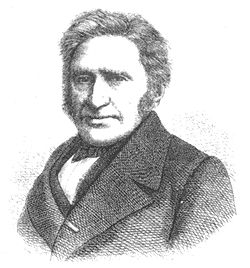
Ludwig Reichenbach
Encyclopedia

Germany
Germany , officially the Federal Republic of Germany , is a federal parliamentary republic in Europe. The country consists of 16 states while the capital and largest city is Berlin. Germany covers an area of 357,021 km2 and has a largely temperate seasonal climate...
botanist and ornithologist.
He was the son of Johann Friedrich Jakob Reichenbach, the author in 1818 of the first Greek-German dictionary. He was the father of Heinrich Gustav Reichenbach
Heinrich Gustav Reichenbach
Heinrich Gustav Reichenbach was an ornithologist, botanist and the foremost German orchidologist of the 19th century...
, equally a botanist and an eminent orchid specialist.
Reichenbach was born in Leipzig
Leipzig
Leipzig Leipzig has always been a trade city, situated during the time of the Holy Roman Empire at the intersection of the Via Regia and Via Imperii, two important trade routes. At one time, Leipzig was one of the major European centres of learning and culture in fields such as music and publishing...
. From 1810 he studied medicine
Medicine
Medicine is the science and art of healing. It encompasses a variety of health care practices evolved to maintain and restore health by the prevention and treatment of illness....
and natural science
Natural science
The natural sciences are branches of science that seek to elucidate the rules that govern the natural world by using empirical and scientific methods...
at the University of Leipzig
University of Leipzig
The University of Leipzig , located in Leipzig in the Free State of Saxony, Germany, is one of the oldest universities in the world and the second-oldest university in Germany...
. He became an instructor in 1818. In 1820 he was appointed the director of the Dresden
Dresden
Dresden is the capital city of the Free State of Saxony in Germany. It is situated in a valley on the River Elbe, near the Czech border. The Dresden conurbation is part of the Saxon Triangle metropolitan area....
natural history museum and a professor at the Surgical-Medical Academy in Dresden, where he remained till 1862. He was later the founder of the Dresden botanical gardens
Botanischer Garten der Technischen Universität Dresden
The Botanischer Garten der Technischen Universität Dresden , also known as the Botanischer Garten Dresden or Dresden Botanical Garden, is a botanical garden maintained by the Dresden University of Technology. It is located in the north-west section of the Großer Garten at Stübelallee 2, Dresden,...
and joint founder of Dresden Zoo
Dresden Zoo
Dresden Zoo, or Zoo Dresden, is a zoo situated in the city of Dresden in Germany. It was opened in 1861, making it Germany's fourth oldest zoo. It was originally designed by Peter Joseph Lenné....
. The museum's zoological collection was almost completely destroyed by the fire in the Zwinger
Zwinger
The Zwinger is a palace in Dresden, eastern Germany, built in Baroque style. It served as the orangery, exhibition gallery and festival arena of the Dresden Court....
palace during the constitutional crisis of 1849, but Reichenbach was able to replace it within only a few years. This collection is the basis of that seen in the museum today.
Reichenbach was a prolific author and able botanical artist. His works included Iconographia Botanica seu Plantae criticae (1823-32, 10 vols.) and Handbuch der speciellen Ornithologie (1851-54).
He was honored by having a plant named after him : Viola reichenbachiana
Viola reichenbachiana
Viola reichenbachiana, the Early Dog-violet, is a violet.This species hybridises with Common Dog-violet to produce Viola × bavarica.-References:...
Jord. ex Bor. (syn. V. sylvatica (Hartm.) Fr. ex Hartm. and V. sylvestris Lam. p.p.) (the Slender Wood Violet). Reichenbach's Sunbird
Reichenbach's Sunbird
The Reichenbach's Sunbird is a species of bird in the Nectariniidae family.It is found in Angola, Cameroon, Central African Republic, Republic of the Congo, Democratic Republic of the Congo, Ivory Coast, Gabon, Ghana, Liberia, and Nigeria.-References:* BirdLife International 2004. . ...
(Anabathmis reichenbachii) is also named after him. This botanist is denoted by the author abbreviation Rchb. when citing
Author citation (botany)
In botanical nomenclature, author citation refers to citing the person who validly published a botanical name, i.e. who first published the name while fulfilling the formal requirements as specified by the International Code of Botanical Nomenclature...
a botanical name
Botanical name
A botanical name is a formal scientific name conforming to the International Code of Botanical Nomenclature and, if it concerns a plant cultigen, the additional cultivar and/or Group epithets must conform to the International Code of Nomenclature for Cultivated Plants...
.
Publications
- Conspectus Regni Vegetabilis (1828)
- Flora germanica excursoria (1830–32, 2 tomes)
- Flora exotica (1834–36)
- Flora germanica exsiccata (1830–45)
- Übersicht des Gewächsreichs und seiner natürlichen Entwickelungsstufen (1828)
- Handbuch des natürlichen Pflanzensystems (1837)
- Das Herbarienbuch (1841)
- Abbildung und Beschreibung der für Gartenkultur empfehlenswerten Gewächse (1821–26, with 96 plates)
- Monographia generis Aconiti (1820, with 19 plates)
- Illustratio specierum Aconiti generis (1823–27, with 72 plates)
- Iconographia botanica s. plantae criticae (1823-1832, with 1,000 plates)
- Iconographia botanica exotica (1827–30)
- Regnum animale (1834–36, with 79 plates)
- Deutschlands Fauna (1842, 2 tomes)
- Vollständigste Naturgeschichte des In- und Auslandes (1845–54, 2 volumes in 9 tomes with more than 1,000 plates)
External links
- Biography (in German)
- Works of Reichenbach at the Open LibraryOpen LibraryOpen Library is an online project intended to create “one web page for every book ever published”. Open Library is a project of the non-profit Internet Archive and has been funded in part by a grant from the California State Library and the Kahle/Austin Foundation.-Books for the blind and...

